Mostrar el registro sencillo del ítem
dc.contributor.author
Mckenna, Duane D.
dc.contributor.author
Wild, Alexander L.
dc.contributor.author
Kanda, Kojun
dc.contributor.author
Bellamy, Charles L.
dc.contributor.author
Beutel, Rolf G.
dc.contributor.author
Caterino, Michael S.
dc.contributor.author
Farnum, Charles W.
dc.contributor.author
Hawks, David C.
dc.contributor.author
Ivie, Michael A.
dc.contributor.author
Jameson, Mary Liz
dc.contributor.author
Leschen, Richard A.B.
dc.contributor.author
Marvaldi, Adriana

dc.contributor.author
Mchugh, Joseph V.
dc.contributor.author
Newton, Alfred F.
dc.contributor.author
Robertson, James A.
dc.contributor.author
Thayer, Margaret K.
dc.contributor.author
Whiting, Michael F.
dc.contributor.author
Lawrence, John

dc.contributor.author
Slipinski, Adam
dc.contributor.author
Maddison, David R.
dc.contributor.author
Farrell, Brian D.
dc.date.available
2018-07-31T19:57:21Z
dc.date.issued
2015-10
dc.identifier.citation
Mckenna, Duane D.; Wild, Alexander L.; Kanda, Kojun; Bellamy, Charles L.; Beutel, Rolf G.; et al.; The Beetle Tree of Life Reveals the Order Coleoptera Survived End Permain Mass Extinction to Diversify During the Cretaceous Terrestrial Revolution; Wiley Blackwell Publishing, Inc; Systematic Entomology (print); 40; 4; 10-2015; 835-880
dc.identifier.issn
0307-6970
dc.identifier.uri
http://hdl.handle.net/11336/53660
dc.description.abstract
Here we present a phylogeny of beetles (Insecta: Coleoptera) based on DNA sequence data from eight nuclear genes, including six single-copy nuclear protein-coding genes, for 367 species representing 172 of 183 extant families. Our results refine existing knowledge of relationships among major groups of beetles. Strepsiptera was confirmed as sister to Coleoptera and each of the suborders of Coleoptera was recovered as monophyletic. Interrelationships among the suborders, namely Polyphaga (Adephaga (Archostemata, Myxophaga)), in our study differ from previous studies. Adephaga comprised two clades corresponding to Hydradephaga and Geadephaga. The series and superfamilies of Polyphaga were mostly monophyletic. The traditional Cucujoidea were recovered in three distantly related clades. Lymexyloidea was recovered within Tenebrionoidea. Several of the series and superfamilies of Polyphaga received moderate to maximal clade support in most analyses, for example Buprestoidea, Chrysomeloidea, Coccinelloidea, Cucujiformia, Curculionoidea, Dascilloidea, Elateroidea, Histeroidea and Hydrophiloidea. However, many of the relationships within Polyphaga lacked compatible resolution under maximum-likelihood and Bayesian inference, and/or lacked consistently strong nodal support. Overall, we recovered slightly younger estimated divergence times than previous studies for most groups of beetles. The ordinal split between Coleoptera and Strepsiptera was estimated to have occurred in the Early Permian. Crown Coleoptera appeared in the Late Permian, and only one or two lineages survived the end-Permian mass extinction, with stem group representatives of all four suborders appearing by the end of the Triassic. The basal split in Polyphaga was estimated to have occurred in the Triassic, with the stem groups of most series and superfamilies originating during the Triassic or Jurassic. Most extant families of beetles were estimated to have Cretaceous origins. Overall, Coleoptera experienced an increase in diversification rate compared to the rest of Neuropteroidea. Furthermore, 10 family-level clades, all in suborder Polyphaga, were identified as having experienced significant increases in diversification rate. These include most beetle species with phytophagous habits, but also several groups not typically or primarily associated with plants. Most of these groups originated in the Cretaceous, which is also when a majority of the most species-rich beetle families first appeared. An additional 12 clades showed evidence for significant decreases in diversification rate. These clades are species-poor in the Modern fauna, but collectively exhibit diverse trophic habits. The apparent success of beetles, as measured by species numbers, may result from their associations with widespread and diverse substrates - especially plants, but also including fungi, wood and leaf litter - but what facilitated these associations in the first place or has allowed these associations to flourish likely varies within and between lineages. Our results provide a uniquely well-resolved temporal and phylogenetic framework for studying patterns of innovation and diversification in Coleoptera, and a foundation for further sampling and resolution of the beetle tree of life.
dc.format
application/pdf
dc.language.iso
eng
dc.publisher
Wiley Blackwell Publishing, Inc

dc.rights
info:eu-repo/semantics/openAccess
dc.rights.uri
https://creativecommons.org/licenses/by-nc-sa/2.5/ar/
dc.subject
Evolution
dc.subject
Nuclear Protein Coding Genes
dc.subject
Phylogeny
dc.subject
Phytophagy
dc.subject
Coleoptera
dc.subject
Strepsiptera
dc.subject.classification
Otras Ciencias Biológicas

dc.subject.classification
Ciencias Biológicas

dc.subject.classification
CIENCIAS NATURALES Y EXACTAS

dc.title
The Beetle Tree of Life Reveals the Order Coleoptera Survived End Permain Mass Extinction to Diversify During the Cretaceous Terrestrial Revolution
dc.type
info:eu-repo/semantics/article
dc.type
info:ar-repo/semantics/artículo
dc.type
info:eu-repo/semantics/publishedVersion
dc.date.updated
2018-07-30T13:37:04Z
dc.journal.volume
40
dc.journal.number
4
dc.journal.pagination
835-880
dc.journal.pais
Reino Unido

dc.journal.ciudad
Londres
dc.description.fil
Fil: Mckenna, Duane D.. Harvard University; Estados Unidos. The University Of Memphis; Estados Unidos
dc.description.fil
Fil: Wild, Alexander L.. University of Texas at Austin; Estados Unidos. University of Arizona; Estados Unidos
dc.description.fil
Fil: Kanda, Kojun. State University of Oregon; Estados Unidos. University of Arizona; Estados Unidos
dc.description.fil
Fil: Bellamy, Charles L.. California Department Of Food And Agriculture; Estados Unidos
dc.description.fil
Fil: Beutel, Rolf G.. Universitat Jena; Alemania
dc.description.fil
Fil: Caterino, Michael S.. Clemson University; Estados Unidos
dc.description.fil
Fil: Farnum, Charles W.. Harvard University; Estados Unidos
dc.description.fil
Fil: Hawks, David C.. University of California; Estados Unidos
dc.description.fil
Fil: Ivie, Michael A.. Montana State University; Estados Unidos
dc.description.fil
Fil: Jameson, Mary Liz. Wichita State University; Estados Unidos
dc.description.fil
Fil: Leschen, Richard A.B.. Landcare Research; Australia
dc.description.fil
Fil: Marvaldi, Adriana. Consejo Nacional de Investigaciones Científicas y Técnicas. Centro Científico Tecnológico Conicet - Mendoza. Instituto Argentino de Investigaciones de las Zonas Áridas. Provincia de Mendoza. Instituto Argentino de Investigaciones de las Zonas Áridas. Universidad Nacional de Cuyo. Instituto Argentino de Investigaciones de las Zonas Áridas; Argentina. Universidad Nacional de La Plata; Argentina
dc.description.fil
Fil: Mchugh, Joseph V.. University of Georgia; Estados Unidos
dc.description.fil
Fil: Newton, Alfred F.. Field Museum Of Natural History; Estados Unidos
dc.description.fil
Fil: Robertson, James A.. University of Georgia; Estados Unidos. University of Arizona; Estados Unidos
dc.description.fil
Fil: Thayer, Margaret K.. Field Museum Of Natural History; Estados Unidos
dc.description.fil
Fil: Whiting, Michael F.. University Brigham Young; Estados Unidos
dc.description.fil
Fil: Lawrence, John. Csiro Ecosystem Sciences; Australia
dc.description.fil
Fil: Slipinski, Adam. Csiro Ecosystem Sciences; Australia
dc.description.fil
Fil: Maddison, David R.. University of Arizona; Estados Unidos. State University of Oregon; Estados Unidos
dc.description.fil
Fil: Farrell, Brian D.. Harvard University; Estados Unidos
dc.journal.title
Systematic Entomology (print)

dc.relation.alternativeid
info:eu-repo/semantics/altIdentifier/doi/https://dx.doi.org/10.1111/syen.12132
dc.relation.alternativeid
info:eu-repo/semantics/altIdentifier/url/https://onlinelibrary.wiley.com/doi/abs/10.1111/syen.12132
Archivos asociados
